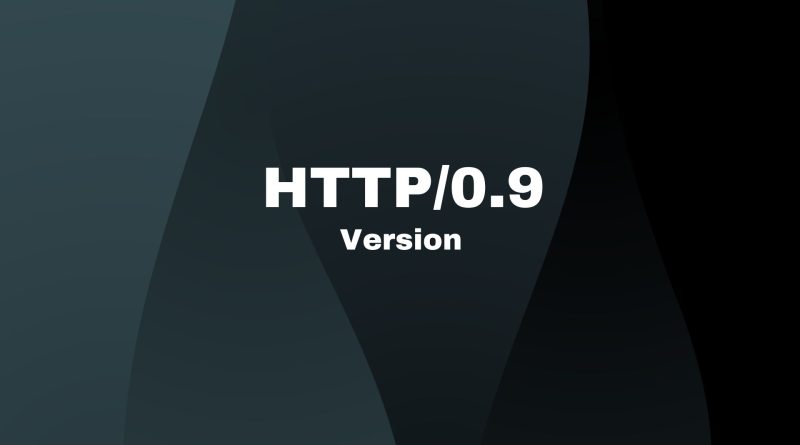HTTP/0.9: A Beginner’s Guide to Understanding the Web’s Earliest Protocol
When it comes to understanding the basics of web development, few topics have created as much confusion and misunderstanding as HTTP/0.9. This protocol was the first major version released by the World Wide Web Consortium (W3C) and is often seen as a relic from an earlier period in computing history. However, regardless of its age, there are still many reasons why someone might need to understand this protocol. In this article, we’ll look at what HTTP/0.9 is all about! We’ll explore how it works, look at the advantages it offered in its era, and more.
Overview
HTTP/0.9 is the earliest version of HyperText Transfer Protocol (HTTP), a system protocol used to transfer data between clients and servers over the internet. It was introduced in 1991 but has since been superseded by newer versions such as HTTP/1.0, HTTP/1.1, HTTP/2 and HTTP/3. Despite its age, it still plays an important role in understanding how modern web protocols have evolved.
HTTP/0.9’s major limitation lies in its lack of support for certain HTTP headers or advanced authentication measures which came later on with subsequent revisions of HTTP; instead, only basic GET requests were available for most operations when using this protocol version. This also meant that support for multiple concurrent connections wasn’t possible either – browsers would need to wait until one connection had been completed before making another HTTP request.
History
HTTP/0.9 was the earliest version of the HTTP protocol, and it was introduced in 1991, at a time when the Internet was still in its early stages of development. The World Wide Web was just starting to gain traction, and there was a growing need for a simple and efficient way to retrieve simple HTML pages from web servers. HTTP/0.9 was designed to meet this need and provide a basic way for clients to communicate with servers.
HTTP/0.9 was developed by Tim Berners-Lee, who is widely considered to be the father of the World Wide Web. Berners-Lee was working at CERN, the European Organization for Nuclear Research, at the time, and he was focused on developing the underlying technologies that would support the Web. HTTP/0.9 was designed to be a simple and straightforward protocol, and it was designed to allow clients to retrieve HTML pages from servers in the most efficient way possible.
Despite its simplicity, HTTP/0.9 played an important role in the early development of the Web. It paved the way for later versions of the HTTP protocol that would provide the foundation for the modern Web. Over time, the protocol evolved to include more advanced features and capabilities, such as support for multiple HTTP requests, headers, and other information. Later versions including HTTP/1.0 and HTTP/1.1, have become the standard for web communication and have replaced HTTP/0.9.
Today, HTTP/0.9 is largely obsolete and is no longer used in modern web development. The protocol has been replaced by later versions, which offer a much richer set of features and capabilities. Despite this, HTTP/0.9 remains an important part of the history of the Web and serves as a reminder of the early days of the Internet and the Web. Check more on the History and Evolution of HTTP.
Features Of HTTP/0.9
HTTP/0.9 is a simple and limited protocol that has the following key features:
- Single request method: HTTP/0.9 only supports a single request method, GET, which is used to retrieve resources from a server.
- No headers or status codes: HTTP/0.9 does not include any headers or status codes, making it a very simple and limited protocol.
- No support for persistent connections: HTTP/0.9 does not support persistent connections, which means that a separate TCP connection must be established for each request.
- No support for chunked transfers: HTTP/0.9 does not support chunked transfers, which is a mechanism for sending large amounts of data in small chunks.
- Limited error handling: HTTP/0.9 has limited error handling, and there is no way to indicate an error in the response.
- Simple response format: HTTP/0.9 uses a very simple response format, and the response consists of the requested resource, with no headers or other information.
These features reflect the limited capabilities of HTTP/0.9 and its simplicity compared to later versions of the protocol. Despite its limitations, HTTP/0.9 played an important role in the early development of the Web, and it paved the way for later versions that would provide the foundation for the modern Web.
What http methods support HTTP/0.9?
HTTP/0.9 only supports the GET method. HTTP/0.9 is a very simple version of the HTTP protocol and was one of the first versions of HTTP to be widely used on the World Wide Web. The GET method is used to retrieve a resource from a server, but it does not support other methods such as POST, PUT, DELETE, or any other advanced features that were added in later versions of HTTP.
Example request and Response
HTTP/0.9 is a very simple and limited version of the HTTP protocol, and it only supports a single request method: GET. Here’s an example of a request and response using HTTP/0.9:
Request
GET /index.html
This request uses the GET method to request the resource /index.html from the server. It does not include any headers or other information, as HTTP/0.9 does not support headers or other advanced features.
Response
<html>
<head>
<title>Example Page</title>
</head>
<body>
<p>This is an example HTML page.</p>
</body>
</html>This response is the HTML content of the resource /index.html that was requested in the previous GET request. It does not include any headers or other information, as HTTP/0.9 does not support headers or other advanced features.
Disadvantages Of HTTP/0.9
HTTP/0.9 was the first version of Hypertext Transfer Protocol (HTTP) and while it has some advantages, it is also accompanied by its own set of disadvantages. One major disadvantage of it is that it only allows for a single request from the client to the server per connection – once the response has been received, the connection between them is terminated. This means that if any additional requests need to be made, a whole new connection must be established.
Another issue is that it does not support headers within HTTP request messages or response messages; this leads to more complicated web page coding as no extra information can be sent along with each request or response. Finally, caching capabilities are limited in this protocol since there are no methods provided for validating the freshness of data on both sides of communication between clients and servers.
Therefore, when compared to newer versions such as HTTP 1.1 which have far better features like persistent connections and header-based communications protocols, HTTP/0.9 clearly lacks many important functionalities required for efficient use today. As we move forward now into exploring the security implications of HTTP/0.9, it’s evident why it isn’t used much anymore given all these limitations.
Security Implications Of HTTP/0.9
When it comes to security, HTTP/0.9 is a major weak spot in the web protocol stack. As an example, there’s no support for encryption or authentication protocols. Consequently, any data that passes through this version of the protocol can easily be intercepted and read by third parties. Even if confidential information isn’t being transmitted over the network, attackers could still hypothetically exploit vulnerabilities in older systems running on HTTP/0.9 to gain access to sensitive resources.
Furthermore, this lack of secure transport layers leaves users vulnerable to man-in-the-middle attacks. These types of attacks involve malicious actors intercepting communications between two endpoints with the intent of manipulating them or stealing data from them. Although these types of attacks aren’t unique to HTTP/0.9, they are much easier to execute when using unencrypted traffic such as what is seen on this version of the web protocol stack.
In addition, because HTTPS was not yet available at the time when HTTP/0.9 was released, cookies were also susceptible to hijacking due to their reliance on URLs instead of headers for delivery across networks. This means that attackers could potentially steal cookie values associated with certain websites and use them later for other malicious activities – something which would have been impossible had modern versions of HTTPS already existed at that point in time. It’s clear then that due to its lack of security features, HTTP/0.9 should never be used in production environments today where user privacy and protection need to be taken seriously. Moving forward we can look into how supporting browsers address this issue within their own implementations of HTTP/0.9
Conclusion
HTTP/0.9 is an obsolete version of the Hypertext Transfer Protocol (HTTP) used for communication between web browsers and servers. It was released in 1991, but its use has been declining since the introduction of more advanced versions such as HTTP/1.0 and HTTP/1.1. Despite being outdated, it still provides a basic level of functionality that can be useful in some cases.
Overall, HTTP/0.9 should not be considered suitable for any new development projects due to its lack of features, security concerns, and limited user agent (browser) support. However, if you find yourself needing to work with legacy systems using this protocol, then understanding how it works may help you achieve your goals faster and with fewer headaches. As long as users are aware of its limitations and potential security issues they could encounter while using it, they can make informed decisions when considering whether or not to use this HTTP protocol on their project or system.
In conclusion, HTTP 0.9 is an old yet simple protocol that has been largely replaced by modern protocols like HTTP/1.0 and 1.1; however, there are situations where knowledge about it might come in handy for developers working on legacy systems or those who want to understand more about how Web communications work at a fundamental level. Therefore we must keep an eye open even for older technologies because sometimes they can provide valuable insights into how things were done before our time!



